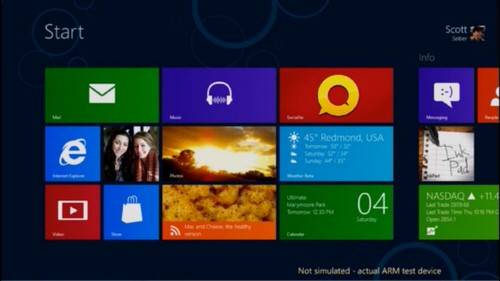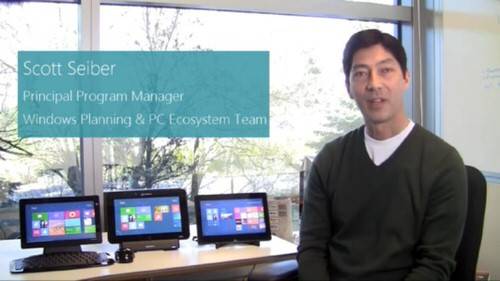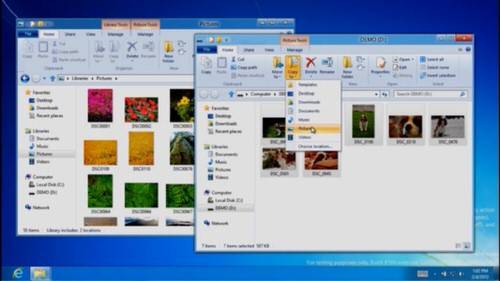While Apple’s preferred method for introducing customers to new products is with a gala stage event, Microsoft’s method has become the doling out of information in carefully timed lumps through corporate blog posts. Today, a rather hefty lump (almost the size of one of my analysis articles) was doled out by Microsoft’s Windows Division President Steven Sinofsky, shedding considerable new light on how Windows 8 will work on systems with ARM-based processors.


ARM is not a processor, like Intel or AMD; rather, it’s a selection of technologies that a manufacturer licenses from an extensive ARM portfolio, that are condensed into a very small system – usually a system-on-a-chip (SoC). In Sinofsky’s blog post today, as well as in an accompanying video – a shot of which is shown above – Microsoft showed three examples of ARM-based devices from (left to right, above) Nvidia, Qualcomm, and Texas Instruments, which don’t use CPUs the way we know them, but behave enough like a PC to run Windows 8. Or at least, a new form of Windows 8 that resembles the Windows we use today only partly.
“Using WOA [Windows on ARM] ‘out of the box’ will feel just like using Windows 8 on x86/64,” writes Sinofsky. “You will sign in the same way. You will start and launch apps the same way. You will use the new Windows Store the same way. You will have access to the intrinsic capabilities of Windows, from the new Start screen and Metro style apps and Internet Explorer, to peripherals, and if you wish, the Windows desktop with tools like Windows File Explorer and desktop Internet Explorer. It will have the same fast and fluid experience. In other words, we’ve designed WOA to look and feel just like you would expect. WOA enables creativity in PC design that, in combination with newly architected features of the OS, will bring to customers new, no-compromise experiences.”
Another World
Yet while Sinofsky made it very clear – in an abundance of words – that Microsoft will not be compromising on what it has not compromised on, today’s blog post does also reveal that those parts of WOA that don’t work “the same way” will work a different way. Most different of all will be the Desktop, which is the part of Windows 7 that used to go by the name “Windows.” As we noted when the Windows 8 Developer Preview was rolled out last September, the Desktop has become just one of two “worlds” where Windows 8 applications will run. The other is a completely new class of “Metro-style” apps, based on a new runtime called WinRT that is not downwardly-compatible. It’s not made for Windows 7, and it’s not compatible with Windows Phone 7.
But at least with Windows 8 on PCs running Intel and AMD architectures (x86/x64), most Windows apps since version 3.0 will run on the Desktop. This will not be the case on Windows for ARM for an obvious and unavoidable reason: Applications compiled to run on these processors are not code-compatible with ARM-based platforms. And managed apps made for the .NET Framework – which as late as Spring 2011 was still being touted as the platform of Windows’ future – will not run on WOA because the .NET Framework is not code-compatible with ARM, at least not at this time. Sinofsky did not state these facts outright, though he gave plenty of information for an eight-year-old to make the correct deduction.

“WOA does not support running, emulating, or porting existing x86/64 desktop apps,” the blog post reads. “Code that uses only system or OS services from WinRT can be used within an app and distributed through the Windows Store for both WOA and x86/64.” It also states that if a developer wishes to target WOA as a platform, all he really needs to do is write a Metro-style app using WinRT and regular OS services.
Another Office
So what is the Desktop for in WOA? Why is it there if it can’t run a great majority of the Windows apps we’ve come to know? Sinofsky states that the WOA Desktop will run built-in versions of Word, PowerPoint, Excel, and OneNote from the new “Office 15” (probably Office 2013). It will also run a desktop version of Internet Explorer 10 (as indicated by a blue “e” icon on the taskbar in the screenshot), as well as the Windows Explorer file manager.
The division president characterizes this degree of resemblance as “supporting the Windows Desktop experience,” adding that applications which can run on the WOA Desktop have been significantly re-architected to support ARM features such as low power consumption and multitouch. At one point, Sinofsky said, the question of how to approach the role of the Desktop for ARM architectures seems ever so faintly like a certain scene from Hamlet:
“To us, giving up something useful that has little cost to customers was a compromise that we didn’t want to see in the evolution of PCs. The presence of different models is part of every platform. Whether it is to support a transition to a future programming model (such as including a virtualization or emulation solution if feasible), to support different programming models on one platform (native and web-based applications when both are popular), or to support different ways of working (command shell or GUI for different scenarios), the presence of multiple models represents a flexible solution that provides a true no-compromise experience on any platform.”
Which must give us pause, Sinofsky might have added.
Another Form Factor
In a statement to ReadWriteWeb this afternoon, IDC program director for applications development software, Al Hilwa, calls WOA “separate but equal… a different OS on its own schedule, but Microsoft is doing its best to deliver it at the same time.”
Hilwa believes that the first WOA-based tablets will be released some time following the first Windows 8-based tablets with Intel and AMD processors, which means this class won’t be ready for back-to-school until 2013. In the meantime, he points out that AMD and Intel are feverishly working to improve the power consumption and efficiency of their CPUs.
Assuming PC manufacturers – especially including those who produce Intel’s Ultrabook form factor – beat ARM producers to market with competitive street prices, and that their Windows 8 PCs run all the existing software (there’s no reason to think they won’t), then they could retain a distinct advantage. Today, Microsoft’s spokesperson told RWW that the work being done by competitors to produce AMD- and Intel-based PCs represents “an equally strong commitment, new designs, and improved architecture for Windows on this hardware. Microsoft could not be more excited or supportive of the new products from Intel and AMD that will be part of Windows 8 across a full spectrum of PC form factors.”
Nevertheless, besides the myriad, perhaps countless, ways in which Windows for ARM is completely different from Windows, it’s just the same as the product you haven’t come to know yet because it hasn’t been released. Because many consumers choose Windows because they need to run Office, Microsoft is making sure that four key Office apps are distributed with WOA. They will use different code bases, but because they’re pre-installed, that fact won’t matter. What will matter is whether consumers feel they’re running Windows while they’re using the applications that are the very reason they use Windows.










